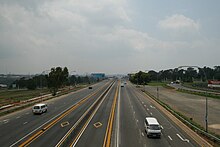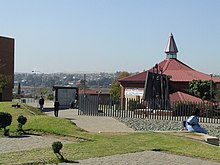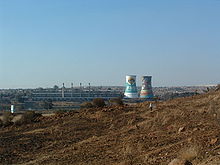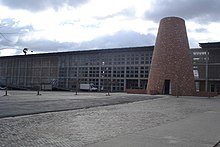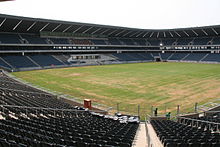Soweto
| Soweto | ||
|---|---|---|
|
|
||
| Coordinates | 26 ° 16 ′ S , 27 ° 52 ′ E | |
| Basic data | ||
| Country | South Africa | |
| Gauteng | ||
| metropolis | City of Johannesburg Metropolitan Municipality | |
| ISO 3166-2 | ZA-GP | |
| Residents | 1,271,628 (2011) | |
| founding | 1963 | |
|
Special features: township |
||
|
View from the Hector Pieterson Museum in Orlando
|
||

Soweto (official name; short for South Western Townships , German about "Südwestliche Vororte") was an amalgamation of numerous township settlements founded in 1963 in the southwest of the South African industrial metropolis Johannesburg . From 1983 to 2002, Soweto was an independent city. Since 2002 it has belonged to the metropolitan municipality of City of Johannesburg .
Since the 1976 Soweto uprising, Soweto has been a symbol of resistance in the apartheid era .
geography
The geographical center of Soweto is around twelve kilometers from the city center (CBD) of Johannesburg.
According to official figures, the population was 1,271,628 in 2011 (2011 census). Unofficial estimates, however, assume a current population of 3.5 million people in an area of 130 km². It is effectively the most populous city in southern Africa .
City structure
Soweto consists of around 30 townships. In alphabetical order these are: Bram Fisherville, Chiawelo, Diepkloof , Dobsonville , Dlamini (also: Dhlamini), Dube , Emdeni, Jabavu, Jabulani, Killarney, Klipspruit, Mapetla, Meadowlands , Mofolo, Molapo, Moletsane, Moroka, Nzimedilophe, Orlando , Phefeni, Phiri, Phomolong, Pimville, Protea, Protea Glen, Senaoane, Snake Park, Tladi, White City, Zola and Zondi. Occasionally, different classifications are mentioned. The origin of the names occasionally indicates which South Africans the township was intended for. For example, the words Naledi ("star") and Phomolong ("place of rest") come from Sesotho .
history
Preconditions for the settlement of Soweto
A declaration made in 1900 is assumed as the starting point for the construction of the south-western township settlements of Johannesburg, according to which the inner-city settlement of Burghersdorp and the adjacent Indian Location become an insanitary area (German literally: unsanitary area; what is meant is: area with insufficient (non-) supply of sanitary facilities ) was explained. In 1902 the authorities set up a commission to investigate those quarters, which should officially develop suggestions for improving the existing sanitary conditions. However, the Johannesburg City Council saw the area close to the center as an area that was far too valuable as a slum area at this point and had already expropriated the landowners in September 1903. The only thing missing so far was a plan in which urban area the 1,600 Indian and 1,400 black residents could be resettled. When the contagious bubonic plague broke out in the Johannesburg slums Coolie Location , Kaffir Location and Brickfields (later Burghersdorp , now Newtown) , the resettlement plan took on an inevitable dynamic. The poor population living here consisted of Europeans, blacks, Indians and coloreds .
Early suburbanization processes in Johannesburg
The first resettlement campaigns by residents of the affected city quarters ( Brickfields ), of whom the able-bodied mostly worked in gold mining, went to the area of the later Soweto to what was then Farm Kliptown in a poor hut settlement, known as a health camp , not far from a sewage facility ( Klipspruit Sewage Farm ). The Johannesburg city administration had installed trickling systems here . Parts of the former settlement of Kliptown were renamed Pimville in 1934 (after James Howard Pim, a Johannesburg city councillor from 1903 to 1907).
This was followed in 1904 on the areas of the former farms Doornkop , Diepkloof , Klipspruit and Vogelstruisfontein . Poor parts of the population from Johannesburg settled here. The inner city dwellings in the area of the Indian Location burned down in a fire. The final house construction for the suburban population shift began on the land of Klipspruit . Since 1904, the Johannesburg mining industry has recruited its main requirement (in some cases almost 90 percent) for simple workers through Mozambican migrants, later politically supported on the basis of the Transvaal-Mozambique Convention .
A second stage took place with the construction of simple houses on a site called Orlando . This area was named in 1935 after a former mayor of Johannesburg, Edwin Orlando Leaky . Orlando is now one of the largest districts of Soweto and consists of two areas, Orlando West and Orlando East , which are located on either side of the four-lane Klipspruit Valley Road expressway . Orlando emerged in the 1930s when the Johannesburg administration began to distribute the city's population according to racially motivated criteria. This mostly happened through violent resettlement actions of the non-European parts of the population from the city center and the previous township settlements Sophiatown ( Western Native Township ), Martindale and Newclare . In 1932 the first medical care station opened here for the local population. At that time the settlement was overpopulated and living conditions were unsanitary.
Settlement expansions in the 1940s
During the Second World War , the Imperial Military Hospital was built near Orlando , where many British soldiers were treated for tuberculosis. The hospital was later renamed Baragwanath Hospital .
Around 1944, on the initiative of the political landless activist James Mpanza, 20,000 squatters immigrated to the Orlando area. Their informal settlements favored the population increase in this area and were mainly concentrated in Orlando West . However, in 1945 the first squatter camp was closed by the authorities.
The authorities set up an emergency camp called Shantytown (literally: "Barrack City") in 1944. Further camps for the landless were added in 1946 as Moroka Emergency Camp and Central Western Jabavu . A clinic was established in Moroka in 1947. Medical care in the growing Johannesburg metropolitan area became increasingly difficult. Therefore, the administration of the Transvaal took over the Baragwanath Hospital and moved the medical care for the black population of Johannesburg from the Johannesburg Hospital to this facility. With 480 beds at the time, it was regarded as the primary care hospital in the Transvaal and has since been the largest on the African continent.
“Soweto” settlements at the beginning of apartheid
After the election victory of the National Party in 1948, the settlement area in the south-west of Johannesburg was expanded in line with the goals of the programmatic racist segregation policy . The Council for Scientific and Industrial Research (German: "Council for Scientific and Industrial Research") and the National Building Research Institute (German: "National Building Research Institute ") developed a settlement model with 4-room houses on a low-cost basis based on a standardized architectural design . This type of construction later shaped the image of Soweto.
Ernest Oppenheimer visited the Orlando settlement in 1950 . Of the unacceptable living conditions of the residents shocked, he negotiated an agreement with the city administration, in which result Oppenheimer a loan in the amount of six million Rand asked for house construction available and the city undertook to repay within 30 years. After all, 24,000 house units were built on this basis in five years.
At the Congress of the People in Kliptown on June 26, 1955, an anti-apartheid paper, called the Freedom Charter , was passed, which in future would form a central basis in the struggle to guarantee or restore human rights in the country.
In 1955, a hostel was opened in Dube to host migrant workers. Male workers now lived here, mostly employed in the service sector for cleaning apartments and who had been expelled from the inner city areas as a result of the Natives (Urban Areas) Amendment Act ( No. 12/1955 ). The hostel model was expanded extensively in the industrial conurbations in the following decades and in this way contributed to the exacerbation of specific social problems.
In 1956 Oppenheimer visited the region again and stayed in Moroka . On the occasion of his visit, he announced another loan of six million rand, which subsequently sparked property speculation. New townships now emerged, which showed a clear ethnic demarcation.
The name Soweto has been officially binding for the entire settlement complex since 1963 . The name prevailed in the course of a four-year competition.
Traffic problems around 1970
At the end of the 1960s, in the course of daily commuter traffic on bus and rail routes between the settlement areas of Soweto on the one hand and the city center of Johannesburg and the industrial areas south of it on the other, increasingly unacceptable conditions. Especially the overcrowding of the suburban trains in the morning hours between 4 and 6 o'clock and for the return traffic in the evening aroused the displeasure of the Soweto people. When the number of passenger accidents, especially those with a fatal outcome, increased significantly, these circumstances attracted national political attention.
When an overcrowded local train coming from Johannesburg crashed in a station at high speed on October 31, 1970, 12 people were killed and 230 were hospitalized. A little over a month earlier, 11 people had died when a freight train wrecked at a station. The Mayor of Johannesburg publicly stated that he feared "another Sharpeville " because of the situation . The South African Railways hired a commission to investigate the accidents, but the Johannesburg City Council asked the Prime Minister of South Africa to have the accidents legally investigated. There was also a dispute because private bus companies were not allowed to use a newly built road due to an objection from the National Transport Commission and had to continue to operate on Booysens Road , which was hit by the traffic jam . This situation was reported in the annual (1970) budget speech of the Minister for Transport in the South African Parliament. According to the 1969–1970 report by the General Manager of Railways, 212,750 passengers a day commuted to and from Soweto using local trains. The provincial administration of the Transvaals began in 1970 with a development plan for the road network in the Pretoria-Witwatersrand-Vereeniging region (today Gauteng ).
Schoolchildren and student protests in 1976
Starting on June 16, 1976, school and student protests rocked Soweto against a government directive to teach half of the upper school classes in Afrikaans instead of English . The riots claimed over 500 victims. Soweto became a symbol of the struggle against apartheid and Soweto Day - today Youth Day - has been a national holiday since 1995 .
Local government bodies since 1983
After Soweto had previously been administratively under the direction of the city of Johannesburg and then administered by the state, it received an elected town council in 1983 on the basis of the Black Local Authorities Act 1982 (Act No. 102/1982 ).
After the end of apartheid
Since 2002, the Hector Pieterson Museum and the Hector Pieterson Memorial in front of the Museum in Orlando have been commemorating the 1976 uprising .
In 2002 Soweto became part of the city of Johannesburg again. The former Soweto was divided into two administrative districts, Districts 6 and 10. As part of an administrative reform, the two districts were merged to form District D.
On February 4, 2011, the University of Johannesburg opened its newly furnished and completely refurbished Soweto campus.
Overall, diverse urban development projects have been implemented in Soweto since 1994. For this purpose, there were also partial plans that only affected and affect individual settlement areas.
population
Even today, mostly black people live in Soweto. All languages recognized as official languages in South Africa are spoken here. Many people from rural areas come to the neighborhood to find work in the neighboring “white” neighborhoods of Johannesburg and the surrounding communities. But suitable jobs are rare and new, small, poor settlements are emerging within a very short time.
Soweto is increasingly visited by tourists. Many areas in Soweto, such as Dube or the Extensions (German "extensions") such as Diepkloof Extension , are inhabited by the black middle class and are therefore among the safest areas in Johannesburg. Informal settlements like Kliptown, on the other hand, are inhabited by the poor and, like some favelas in Brazil , were among the most dangerous places in the world.
Many of the residents of Soweto have organized themselves in neighborhoods to protect themselves from criminals.
In Vilakazi Street in the district of Orlando, the two lived Nobel Peace Nelson Mandela and Desmond Tutu .
Infrastructure
Social infrastructure
According to various sources, the Chris Hani Baragwanath Hospital in Diepkloof is the largest hospital in the world, the southern hemisphere and Africa. The Avalon Cemetery in the southwest of Soweto is the largest cemetery in South Africa and is now no longer receptive.
Regina mundi , located in Orlando East, is the largest Catholic church in South Africa. The community work that goes out from here is of great importance to the residents of Soweto. There are several community centers. Nelson Mandela arranged in 1997 to commemorate and honor the commitment anchored here in achieving democracy in South Africa that November 30th should be celebrated as Regina Mundi Day .
traffic
The national road N1 leads east, the N12 south and east past Soweto. Other expressways, some of them multi-lane, run through Soweto. Buses and shared taxis run frequently.
Metrorail Gauteng trains take passengers to Johannesburg and Vereeniging from numerous Soweto stations . You can also use the Metrorail to reach Pretoria and the surrounding area via the transfer option at Johannesburg Park Station . A connection of Soweto to the Gautrain local transport system was discussed, but has not yet been implemented.
Baragwanath Airfield is located just east of Soweto .
water
The Nancefield Sewerage Farm in Pimville is an urban heritage site. 1733 kilometers of main water pipes and 1962 kilometers of main sewer pipes and 17 water reservoirs are available for the modern water management of Soweto . There is also a sewage pump station ( Daveland ) and a sewage treatment plant ( Goukoppies ) on the territory of the district .
Attractions
- The Thokoza Park in Rockville ( Ntuli Street to the corner of Chris Hani Road ) is an approximately 4.5 hectare green area with water surfaces that is used for local recreation .
- The Mandela House Museum ( Soweto and the Mandela House museum ) in Orlando West ( Vilakazi Street , corner of Ngakane Street ) provides information about the Nelson Mandelas family and other figures of the anti-apartheid movement. The former house of Mandela, who lived here from 1946 and was integrated into the museum grounds, was built in 1945 in the form of a standardized architectural design by the city of Johannesburg.
- The Regina Mundi Catholic Church in Rockville ( Khumalo Street ) was built in 1961 and opened on July 24, 1962. It was a center of the opposition movement during apartheid, church services or funeral ceremonies often turned into a political manifestation. After this period, the building served as a meeting place for the Truth and Reconciliation Commission in addition to its actual purpose . In the surrounding garden there is a memorial stone of Japanese Christians in memory of the victims of the Soweto uprising in 1976.
- The Hector Pieterson Memorial and Museum in Orlando West ( Khumalo Street ) is a memorial to the victims and events during the 1976 Soweto Uprising .
- The Morris Isaacson High School in Jabavu ( Mputhi Street ) symbolizes the central points of the student protests in Soweto on June 16, 1976. The school was founded in 1956 as the Mohloding School and at that time offered 300 students teaching opportunities. It was later named in honor of Morris Isaacson , a Jewish émigré from Lithuania , who, as a successful trader in Johannesburg, set up a fund to ensure that black students completed a university-level education .
- The Walter Sisulu Square is a memorial and information facility in Kliptown ( Klipspruit Valley Road , corner of Union Road ). Here there is an open-air museum, a memorial to the Freedom Charter with the 10 pillars (10 steles) as a group symbol for the 10 articles of the Charter, a multifunctional hall and the Soweto Hotel by Holiday Inn .
- The Oppenheimer Gardens are a park in Western Jabavu or Jabulani ( Majoeng Street , corner to Ntsane Street ) and, together with the Credo Mutwa Cultural Village and the Oppenheimer Tower (Oppenheimer Tower) built in 1957 , form a cultural monument administered by the city of Johannesburg. Trees and sculptures characterize the small park. It was created in honor of Ernest Oppenheimer , who with large loans contributed to the construction of permanent houses here. With the Credo Mutwa Cultural Village , the area has an open-air museum for African sculptures. In the garden area there are regional medicinal plants, aloes, cabbage trees, wild olive trees, coral trees as well as the Cape leadwort and Senecio tamoides .
- The Gerard Sekoto House in Kliptown ( Beacon Road ) is a municipal monument. It is reminiscent of the painter Gerard Sekoto , who lived in Sophiatown as a young artist . The Johannesburg Art Gallery honors him with an annual Gerard Sekoto Youth Festival .
- In the southwest Soweto is the 1972 opened Avalon Cemetery ( Avalon Cemetery ), were buried in the well-known anti-apartheid activists. It is located in the Soweto-Chiawelo district ( Tshabuse Street ). The Lenasia Crematorium is located on its southern edge .
- The former coal-fired power station in Orlando ( Orlando Power Station ) in Klipspruit ( Klipspruit 318-Iq ), construction of which began in 1935, was shut down in 1998 and, from 2006, was partially converted for commercial use. The area is well known regionally as a leisure area. In 2014 buildings collapsed here, causing harm to people. The two former cooling towers are visible from afar.
- The home ground of the Orlando Pirates football club is the Orlando Stadium in Orlando East ( Mooki Street ), which is now a modern stadium. Its predecessor was built in 1959 and was later heavily damaged by vandalism.
- The Kaizer Chiefs , another nationally known football club in South Africa, play in Soccer City in Nasrec ( Soccer City Avenue ) immediately north of Soweto .
There are several companies in the tourism industry that offer themed tours of Soweto. This includes a tour through the urban area designed for cycle tourists.
Artist in Soweto
Numerous artists live or lived in Soweto, including the musicians Yvonne Chaka-Chaka , Brenda Fassie , Sipho Mabuse , Sibongile Khumalo and Vusi Khumalo . Soweto is considered to be the birthplace of Kwaito music, which is played by Arthur Mafokate , Mandoza and Bonginkosi Dlamini , called "Zola" after his place of residence , among others . The Soweto Art and Craft Fair at the Soweto Theater in Jabulani sells works by artists and craftspeople from Soweto.
Around 1990, Matlhaela Masote founded the Soweto Youth Orchestra, which later became the Soweto Symphony Orchestra . The Soweto String Quartet was founded by members of the orchestra. It plays classical music, but also picks up on traditional African music and pop music. The Soweto Gospel Choir , founded in 2002, is known beyond the borders of South Africa.
The artist John Koenakeefe Mohl lived in Soweto from the late 1950s until his death in 1985. He painted and gave lessons in piano, painting, sculpture and floristic work. Mohl was a teacher at Madibane High School and Orlando High School .
One of the most famous works of art in Soweto is the painting Madonna and Child in Soweto in Regina Mundi Church, which Lawrence Scully created in the 1970s. Both are black; the child holds one hand as a sign of victory.
media
The daily newspaper The Sowetan has been published in Johannesburg since 1981 with a circulation of almost 100,000. Soweto TV is a local television broadcaster that is free to receive in Gauteng Province. Its headquarters are on Vilakazi Street in Orlando.
Sports
Soweto is home to top division soccer clubs Orlando Pirates , Kaizer Chiefs and Moroka Swallows . In nearby Soweto, Soccer City , Africa's largest stadium, several games of the 2010 World Cup took place, including the final.
sons and daughters of the town
- Letta Mbulu (born 1942), singer
- Kaizer Motaung (* 1944), founder and chairman of the Kaizer Chiefs football club
- Thokozile Masipa (* 1947), lawyer
- Sipho Mabuse (* 1951), musician
- Cyril Ramaphosa (* 1952), lawyer, union leader and politician
- Tokyo Sexwale (* 1953), anti-apartheid activist and politician
- Manala Manzini (* 1955), head of the South African secret service
- Santu Mofokeng (1956-2020), photographer
- Sibongile Khumalo (* 1957), singer
- Tsietsi Mashinini (1957–1990), leader of the Soweto uprising
- Vusi Khumalo (* 1960s), jazz musician
- Lebo M (* 1964), composer
- Hector Pieterson (1963–1976), victim of Apartsheids
- Yvonne Chaka Chaka (* 1965), pop singer
- Pule Pheto (* 1966), jazz and improvisation musician, music producer
- Doctor Khumalo (* 1967), football player
- Lucas Radebe (* 1969), football player
- Watu Kobese (* 1973), chess player
- Jacob Lekgetho (1974-2008), football player
- Mandoza (1978-2016), Kwaito musician
- Gift Mpho Leremi (1984-2007), football player
- Siphiwe Tshabalala (* 1984), football player
- Thulani Serero (* 1990), football player
Web links
- City of Johannesburg: Soweto . on www.joburg.org.za official website (English)
- Helena Pohlandt-McCormick: Soweto: History, Geography, Society . at www.gutenberg-e.org (English)
Individual evidence
- ↑ 2011 census , accessed October 4, 2013.
- ↑ - ( Memento of October 24, 2008 in the Internet Archive )
- ↑ a b c d City of Johannesburg: Locals love Orlando . at www.joburg.org.za ( Memento from January 11, 2015 in the Internet Archive ) (English)
- ↑ a b c d e f g h i j k City of Johannesburg: The making of Soweto . at www.joburg.org.za ( Memento from December 8, 2015 in the Internet Archive )
- ^ A b Elsabe Brink: Heritage Assessment Fordsburg, Newton West, Mayfair . Fordsburg Heritage Survey, Johannesburg 2008. on www.joburg-archive.co.za, PDF document p. 2, 20 ( 1904 Johannesburg's first forced removal, destruction of the Indian location ) ( Memento from December 22, 2014 in the Internet Archive ) (English)
- ↑ https://www.joburg.org.za/play_/Pages/Play%20in%20Joburg/Culture%20and%20Heritage/Links/Chronology-of-events-in-the-making-of-Soweto-.aspx
- ↑ James Ball: The Preservation of Pimville Soweto . on www.theheritageportal.co.za (English)
- ^ Ruth First : The gold of migrant labor . In: Africa South, Vol. 5, Edition 3 (April-June 1961) pp. 7–31 (here p. 13), online at www.disa.ukzn.ac.za Download link
- ↑ SAhistory: Johannesburg the segregated city . on www.sahistory.org.za ( Memento from October 4, 2014 in the Internet Archive )
- ^ Diana Rose Cammack: The Rand at War, 1899-1902: The Witwatersrand and the Anglo-Boer War . London 1990, p. 191, online at www.books.google.de (English)
- ↑ Built in 1945, occupied by Mandela in 1946 and increasingly irregularly inhabited until 1961. In 1990 Mandela's place of residence for eleven days. Restored from 1998, since 1999 Mandela House Museum . - See: Mandela House , engl. In: mandelahouse.com , accessed November 15, 2010.
- ↑ An Overview of Soweto . on www.soweto.co.za (English)
- ^ A history of Soweto . on www.sahistory.org.za (English)
- ^ SAIRR : A Survey of Race Relations in South Africa 1970 . Johannesburg 1971, pp. 200-201
- ^ SAIRR : A Survey of Race Relations in South Africa 1971 . Johannesburg 1972, pp. 170-201
- ^ Province Gauteng. Department of Roads and Transport: Development of a twenty five year Integrated Transport Master Plan (ITMP25) for the Gauteng Province . 2011. on www.itssa.org, PDF document p. 2 ( Memento from January 10, 2015 in the Internet Archive ) (English)
- ↑ Padraig O'Malley: 1982. Black Local Authorities Act . on www.nelsonmandela.org (English)
- ↑ - ( Memento of September 13, 2008 in the Internet Archive ) PDF file
- ^ City of Johannesburg: UJ opens Soweto Campus . Information from February 7, 2011 on www.joburg.org.za ( Memento from January 10, 2015 in the Internet Archive ) (English)
- ^ Johannesburg Development Agency: Kliptown. Development Feasibility Report . at www.jda.org.za (English)
- ^ Regina Mundi Church: About us . on www.reginamundichurch.co.za (English)
- ^ Metrorail: Gauteng Rail Map . on www.metrorail.co.za (English)
- ↑ http://pmg-assets.s3-website-eu-west-1.amazonaws.com/WATER_AND_SANITATION_APP_201819_VOTE_36_WEB_FILE.pdf
- ^ Gauteng Tourism Authority: Thokoza Park . on www.gauteng.net (English)
- ^ Gauteng Tourism Authority: Soweto and the Mandela House museum . on www.gauteng.net (English)
- ^ Mandela House . on www.mandelahouse.com (English)
- ^ Gauteng Tourism Authority: Regina Mundi Catholic Church . on www.gauteng.net (English)
- ^ Regina Mundi Church. on www.reginamundichurch.co.za (English)
- ^ City of Johannesburg: The Queen of Soweto . at www.joburg.org.za ( Memento from April 13, 2015 in the Internet Archive )
- ^ Gauteng Tourism Authority: Hector Pieterson Memorial and Museum . on www.gauteng.net (English)
- ↑ Sowto Tourism Information Center: About Walter Sisulu Square . on waltersisulusquare.co.za ( Memento from January 6, 2015 in the Internet Archive )
- ↑ Heritage Portal: Oppenheimer Gardens and Credo Mutwa Cultural Village . on www.heritageportal.co.za ( Memento from January 11, 2015 in the Internet Archive ) (English)
- ^ SA venues: The Oppenheimer Gardens . on www.sa-venues.com (English)
- ^ Gerard Sekoto Foundation. on www.gerardsekotofoundation.com (English)
- ^ City of Johannesburg: Art rules the day at JAG . at www.joburg.org.za ( Memento from April 13, 2015 in the Internet Archive )
- ↑ City of Johannesburg: The Avalon Cemetery . on www.joburgtourism.com (English)
- ^ City of Johannesburg: Avalon's thousands of graveside cots . on http://www.joburg.org.za ( Memento from April 13, 2015 in the Internet Archive ) (English)
- ^ Gauteng Tourism Authority: Orlando Towers . on www.gauteng.net (English)
- ^ Stadium Management South Africa: Orlando Stadium . on www.stadiummanagement.co.za (English)
- ^ Gauteng Tourism Authority: FNB Stadium / Soccer City . on www.gauteng.net ( Memento from January 17, 2015 in the Internet Archive )
- ↑ Description at citysightseeing-blog.co.za (English), accessed on January 17, 2015
- ↑ SAhistory: John Koenakeefe Mohl . on www.sahistory.org.za (English)
- ↑ Description at interfaithmary.net (English), accessed on January 17, 2015
- ↑ Article on editions of South African newspapers , accessed on April 27, 2015
- ↑ Description of Vilakazi Street at sa-venues.com (English), accessed on January 17, 2015





